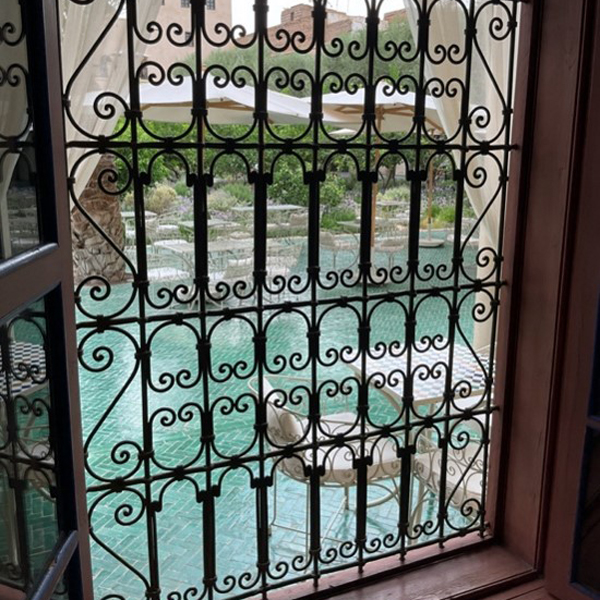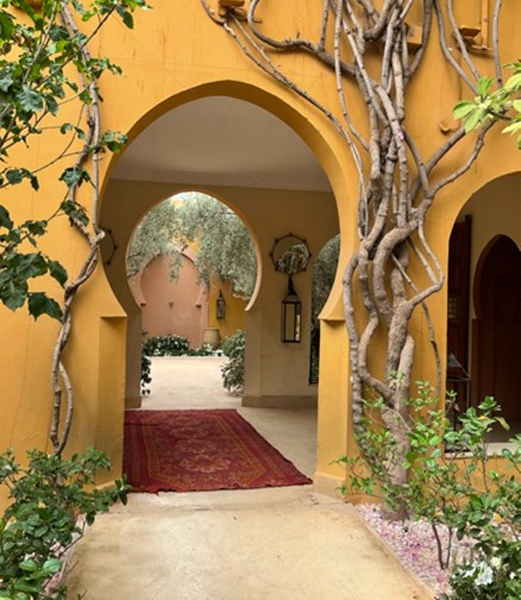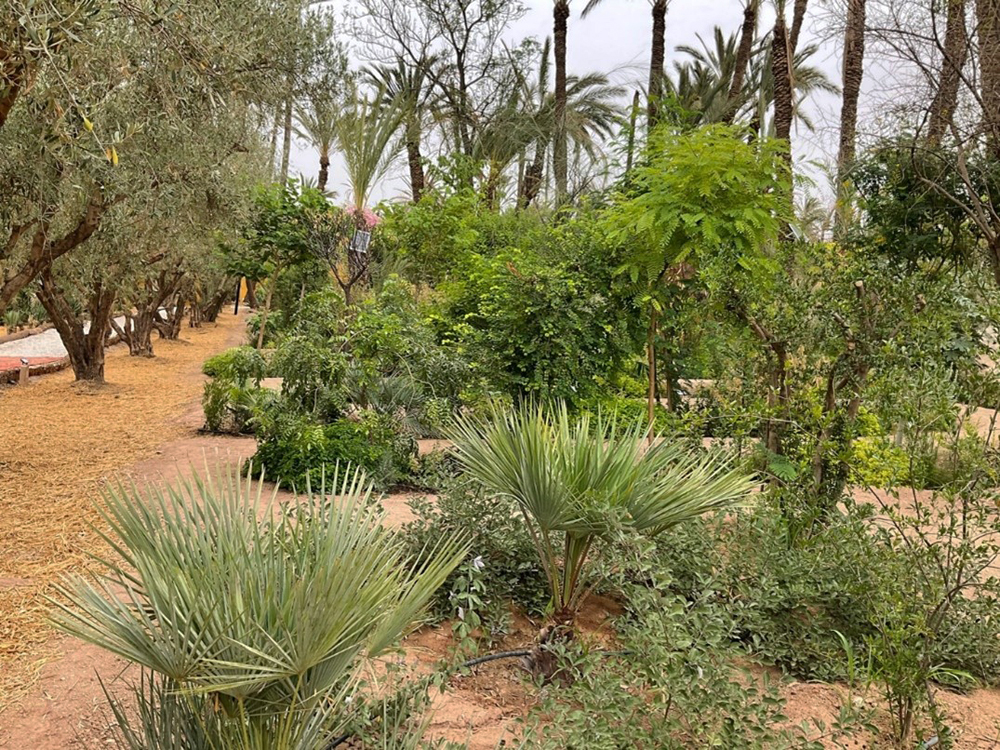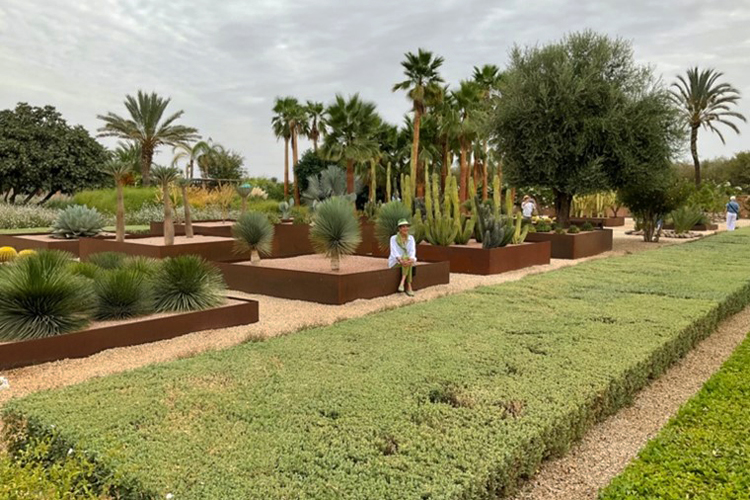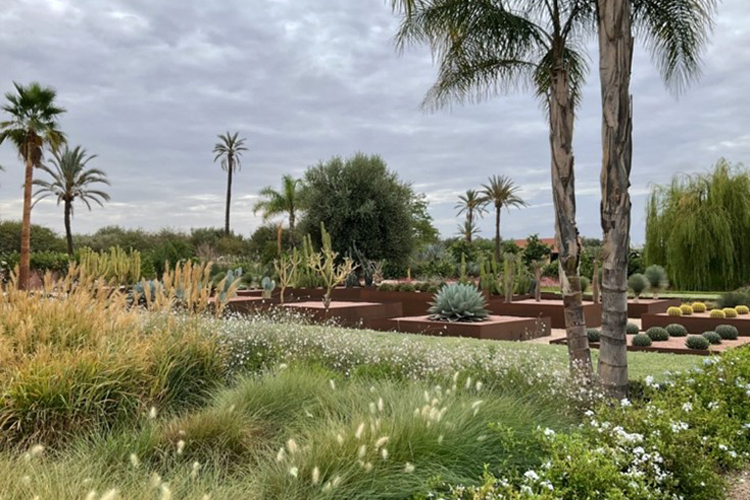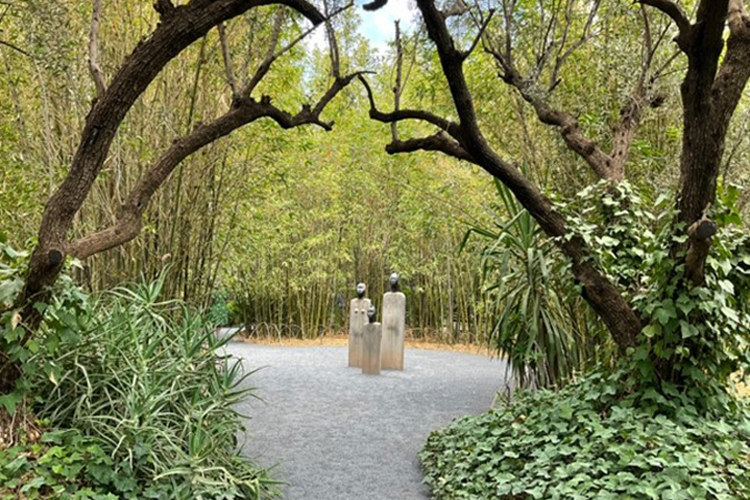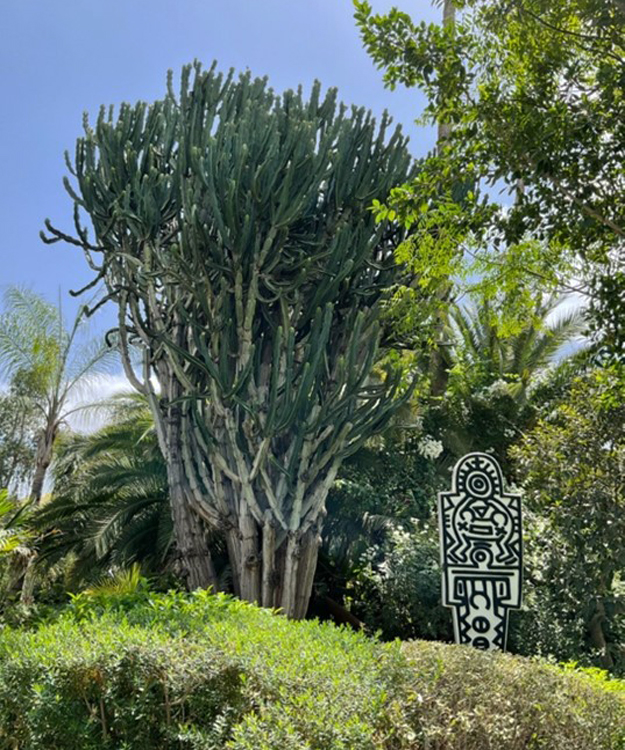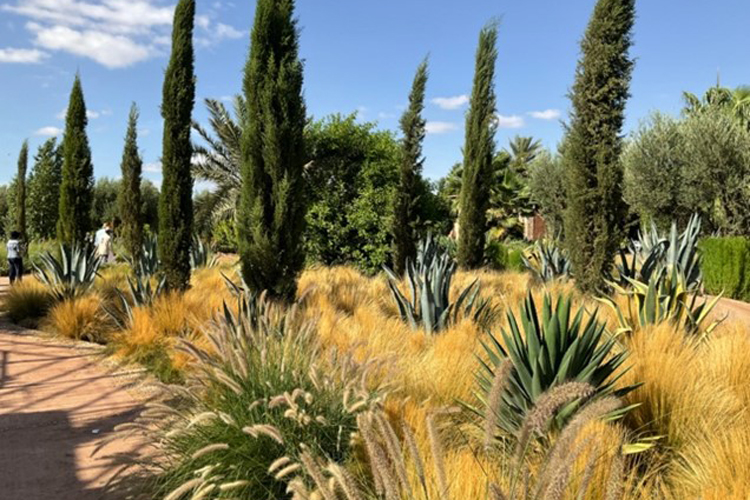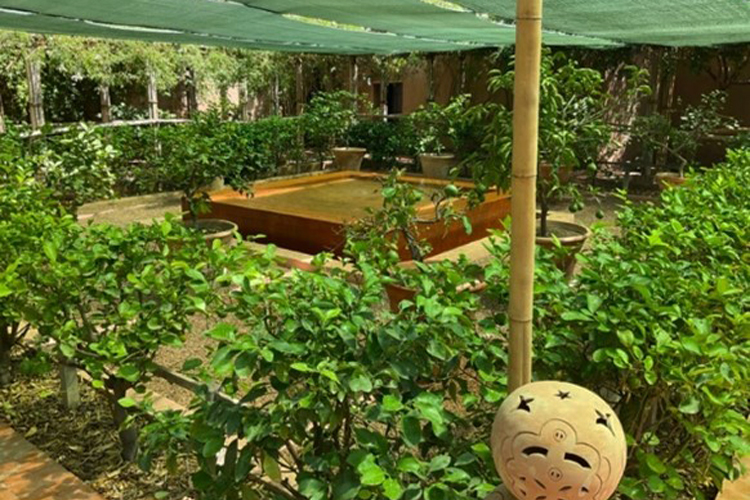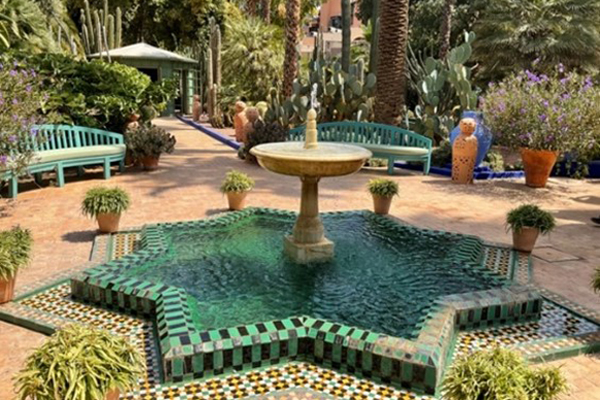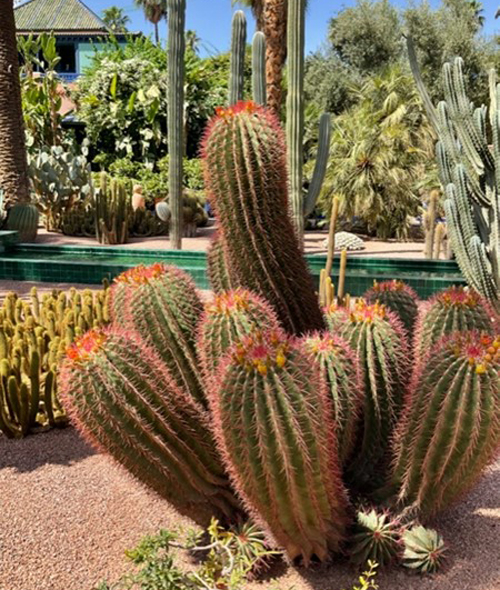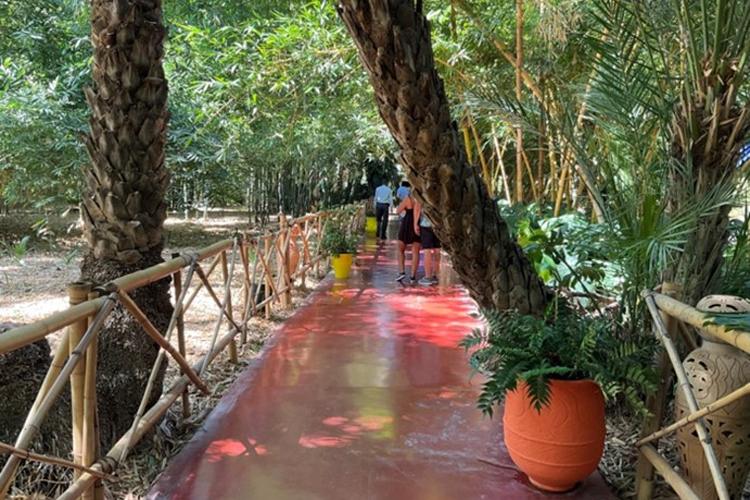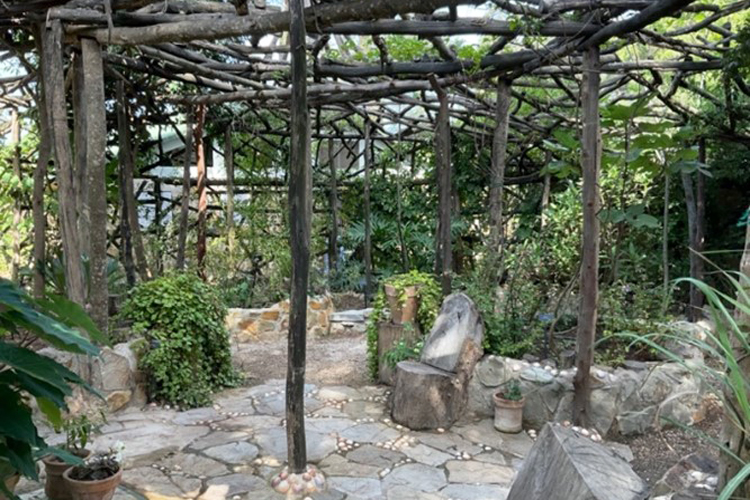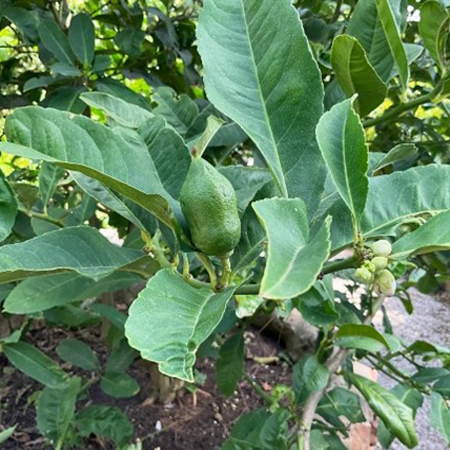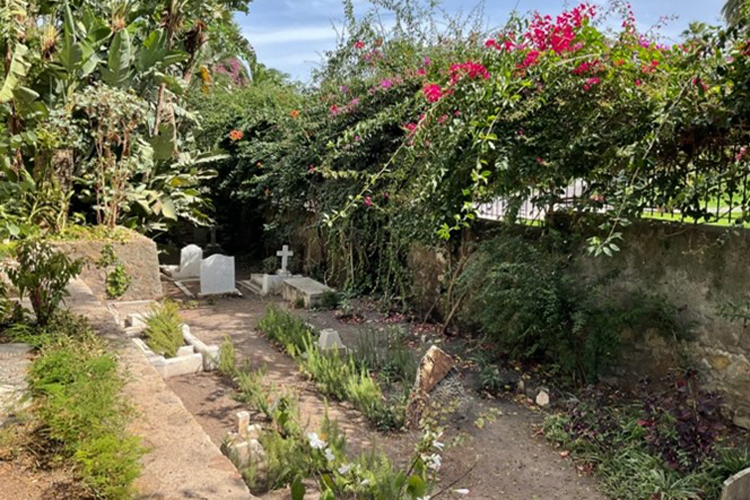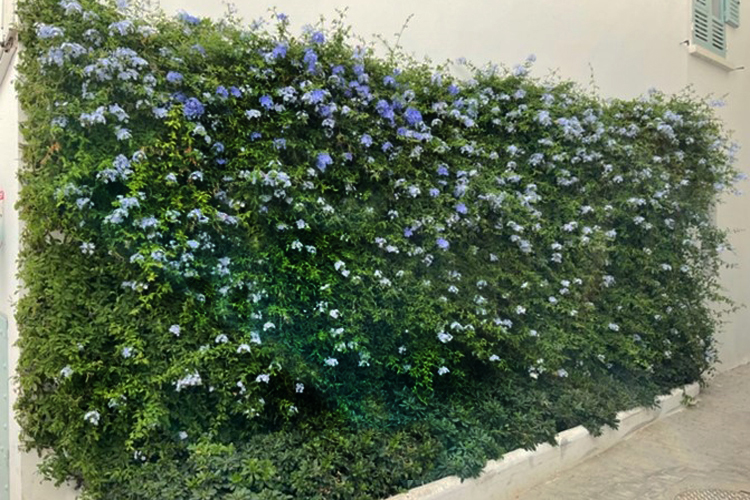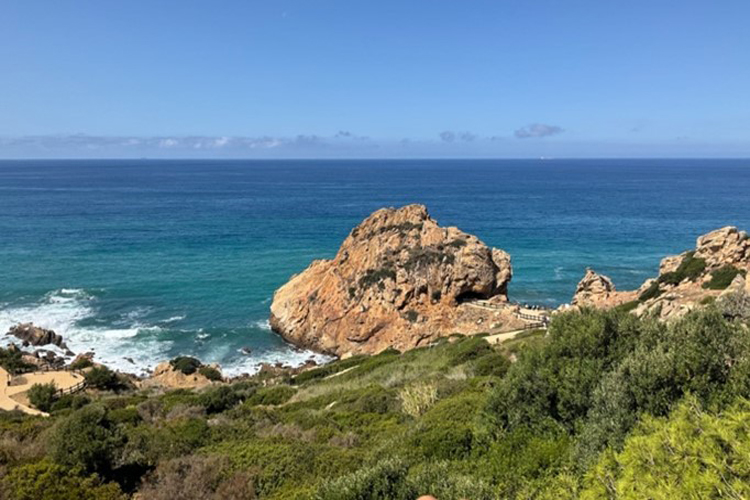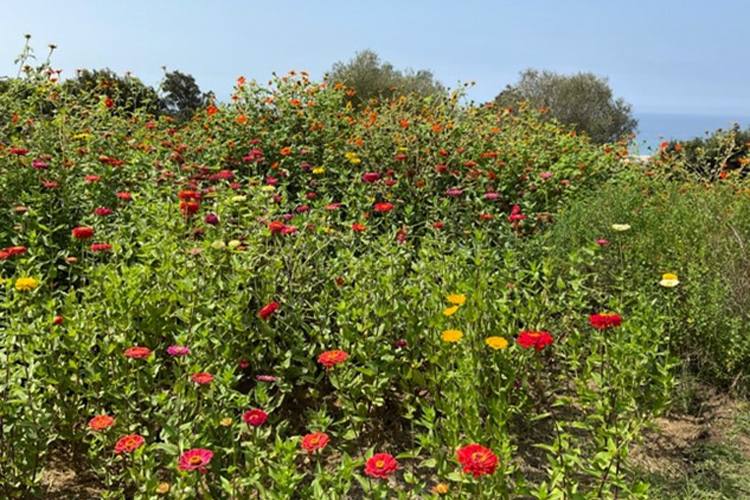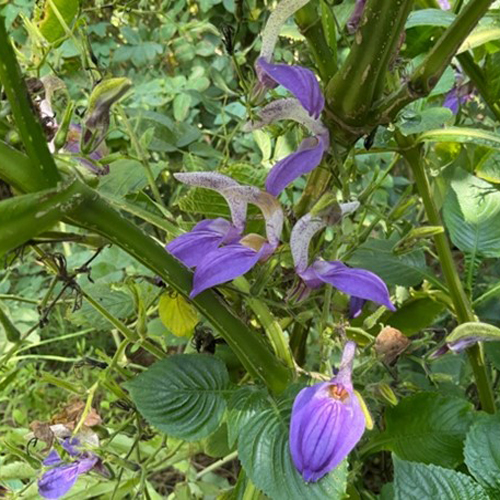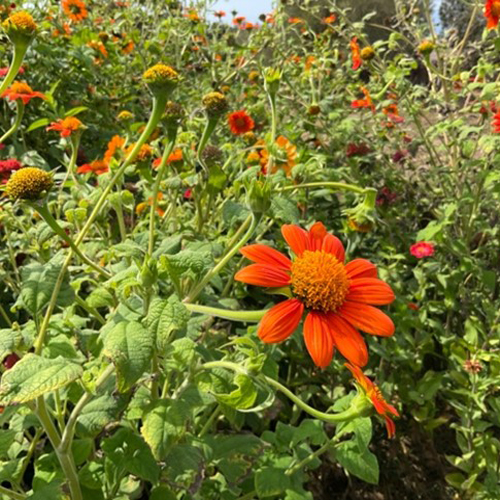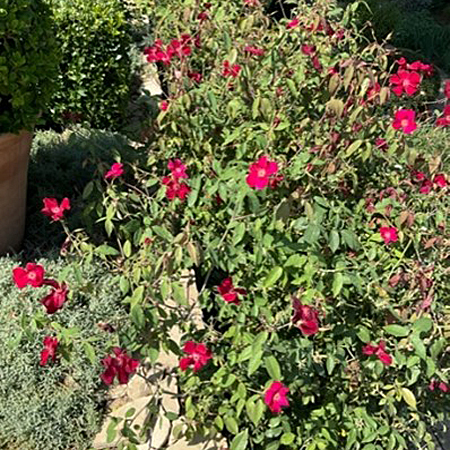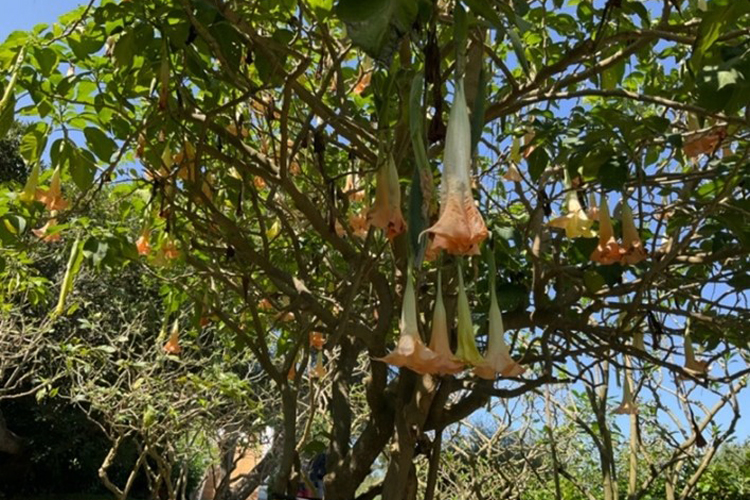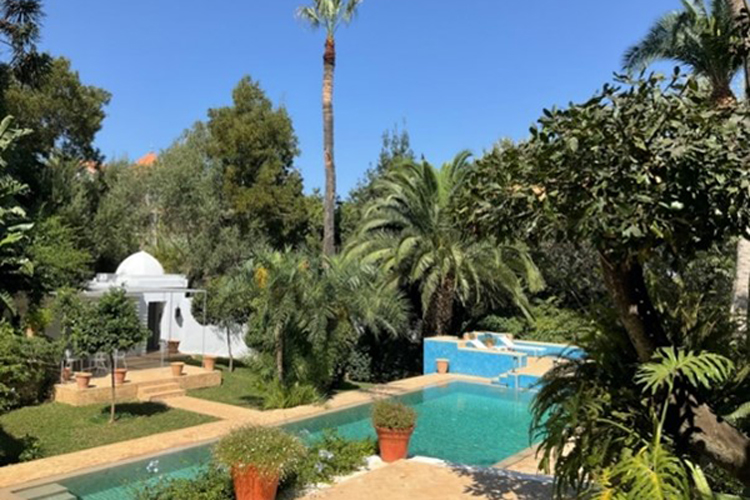September / septembre 2022
Gardens of Marrakesh and Tangier / Jardins de Marrakech et Tanger
Click on the images to enlarge them / Cliquez sur les images pour les agrandir
Chantal Guiraud writes:
In September 2022, I went on an MGS trip organized by Angela Dunford, head of the Italian branch of the MGS. We had been waiting for this trip since 2020, it having been postponed several times due to the pandemic. I was really looking forward to arriving in a country that I had visited so many times during my childhood, as my entire maternal family had lived there. Having not been in Morocco since 2007, on this visit I found the people even more welcoming than before. I found a peaceful and joyful atmosphere and was able to stroll through the souks without being harassed by the vendors. I rediscovered the flavours of my childhood, including the sweet juice of the seedless white grape we called Doigt de Demoiselle because of its elongated shape, found by chance in an alley in Marrakech. I searched for a long time for the sfenj doughnuts sold on the Jemaa El-Fnaa square, without success. However, we found and devoured msemen (pancakes drizzled with honey) for breakfast. But let’s get back to our subject: the gardens.
Chantal Guiraud écrit :
En septembre 2022, j’ai participé à un voyage MGS organisé par Angela Dunford, présidente de la branche italienne de la MGS. Nous attendions avec impatience ce voyage depuis 2020, reporté à plusieurs reprises à cause de la pandémie. J’avais vraiment hâte d’arriver dans ce pays combien de fois visité durant mon enfance, car toute ma famille maternelle y avait résidé. Mon dernier séjour datait de 2007 et j’avoue que j’ai retrouvé un peuple marocain toujours plus accueillant que jamais et une atmosphère paisible et joyeuse. J’ai pu déambuler dans les souks sans être harcelée par les vendeurs. J’ai retrouvé les saveurs de mon enfance, comme le jus sucré du raisin blanc sans pépins que nous appelions « Doigt de Demoiselle » à cause de sa forme allongée, retrouvé au hasard d’une ruelle à Marrakech. J’ai longtemps cherché les beignets « sfenj » vendus sur la place Jemaa El-Fnaa, sans succès. Mais nous nous sommes gavés de crêpes « msemen » arrosées de miel au petit déjeuner. Mais revenons à notre sujet : les jardins.
We began the trip with a welcome party in Le Jardin Secret, visited in 2016 by MPG, three days before it opened to the public. Given the late hour, we were unable to visit the garden in detail, but we very much enjoyed our reunion with members from Australia, California and elsewhere and the performance by a troupe of musicians and gnawa dancers from the High Atlas. It was a very successful evening, and we promised to come back during the daytime to visit this haven of peace in the centre of the medina.
Nous avons débuté ce voyage par une soirée d’accueil dans le Jardin Secret, visité en 2016 par la MPG, 3 jours avant son ouverture au public. Nous n’avons pu visiter le jardin en détail, vu l’heure tardive, mais avons profité pleinement de nos retrouvailles avec les membres d’Australie, de Californie ou d’ailleurs, accompagnés par une troupe de musiciens et danseurs « gnawa » du Haut-Atlas. Soirée très réussie, en nous promettant de revenir de jour visiter ce havre de paix en plein centre de la médina.
The following day, we began with a visit to Cactus Thiemann, which at 7 hectares and with more than 150 species is the largest cactus garden in Africa. Its largest specimen is an 8m high Pachycereus pringlei, brought from Europe by founder Hans Thiemann 40 years ago. His widow and two daughters now run the nursery and regularly supply the gardens we would be visiting on our trip.
Le lendemain, notre journée commence avec la visite du jardin de cactées des filles Thiemann. C’est le jardin de cactées le plus grand d’Afrique, s’étalant sur presque 7 hectares et comptant plus de 150 espèces. Son plus grand spécimen est un Pachycereus pringlei de 8 m de haut qui a été apporté d’Europe par le fondateur Hans Thiemann il y a 40 ans. Sa veuve et ses deux filles dirigent la pépinière et fournissent régulièrement les jardins que nous visiteront.
Next, we immersed ourselves in the impressive Mohammed VI Museum for the civilisation of water in Morocco. The focus was on the Moroccan genius for water management. We discovered how, centuries ago, hydraulics allowed the creation of the first gardens in the desert; how, even today, traditional practices of sharing and valuing water operate across oases, mountains and plains; how, in ancient cities, water reached public fountains for cooking, bathing and watering gardens and orchards. Finally, the museum examined the challenges of water resources in the country today, resulting from the impact of climate change and population growth.
Puis nous nous immergerons dans l’impressionnant Musée Mohammed VI pour la civilisation de l’eau au Maroc. Le génie marocain dans la gestion de l’eau en est le point de mire. Nous découvrons ainsi, comment, il y a des siècles auparavant, l’hydraulique permettait la création des premiers jardins dans le désert ; comment, même encore aujourd’hui, les pratiques traditionnelles de partage et valorisation de l’eau fonctionnent au travers des oasis, des montagnes et des plaines ; comment, dans les cités anciennes, l’eau arrivait jusqu’aux fontaines publiques pour cuisiner, se baigner et arroser jardins et vergers. Et enfin, sont étudiés les challenges auxquels le pays doit faire face en raison de l’impact du changement climatique et de la croissance démographique sur les ressources en eau.
Unfortunately, this museum does not attract many Moroccans, perhaps because the entrance fee is too high for them. Yet it invites visitors to ask themselves hard-hitting questions, such as: “Have you ever thought about the fact that the water you drink today is the same water that existed millions of years ago, because of the natural water cycle?”
Malheureusement, ce musée n’attire pas beaucoup de marocains, peut-être en raison du prix de l’entrée trop élevé pour eux. Pourtant, il invite les visiteurs à se poser des questions percutantes, comme celle-ci : « vous est-il jamais arrivé de penser que le cycle naturel de l’eau fait que l’eau que vous buvez aujourd’hui est la même que celle qui existait il y a des millions d’années ? »
Our next visit was to the boutique hotel Jnane Tamsna, owned by ethnobotanist Gary Martin and his wife Meryanne Loum-Martin. It lies in Marrakech’s palm grove. Dating from the 11th century, and established after the arrival of the Islamic Almoravids, this is the only palm grove north of the High Atlas. It extends over 13,000 hectares and contains 100,000 palm trees irrigated by underground canals called khettaras. The palm trees are useful for the production of dates and to shade the cultivated fields. This delicately balanced ecosystem is under threat from climate change and from the recent exponential growth of Marrakech.
Notre prochaine visite, le boutique hôtel « Jnane Tamsna » appartenant à l’ethnobotaniste Gary Martin et son épouse Meryanne Loum-Martin. Il se situe dans la palmeraie de Marrakech que nous traverserons. Datant du XIème siècle, suite à l’arrivée de la caravane des Almoravides, c’est la seule palmeraie située au nord du Haut Atlas. Elle s’étend sur 13 000 hectares et contient 100 000 palmiers irrigués par des canaux souterrains nommés « khettaras ». Outre la production de dattes, les palmiers font de l’ombre aux champs cultivés. Cet écosystème équilibré avec délicatesse se trouve sous la menace du changement climatique et de la croissance exponentielle de Marrakech de ces dernières années.
Jnane is the plural of jnana – the Arabic word for the paradise garden described in the Koran. Over time, the word has evolved to mean a form of garden that includes fruit trees, palms and vines. The property also has a vegetable garden, where Gary passionately and carefully cultivates a wide variety of vegetables, fruit and herbs.
« Jnane » est le pluriel de « jnana » -le mot arabe qui désigne le jardin du paradis dans le Koran. Avec le temps, le mot a évolué pour désigner une forme de jardin qui englobe des fruitiers, des palmiers et de la vigne. La propriété possède donc également un potager, où Gary cultive avec passion et attention une grande variété de légumes, de fruits et de plantes aromatiques.
Gary, founder of the Global Diversity Foundation, has been involved in ecological ethnobotanical work for over 30 years. He has created a unique garden of around 9 hectares, rich in both botanical and cultural diversity. Gary follows the principles of permaculture and practices Hügelkultur. This is a technique where a self-fertilising mound is created using compostable materials and is particularly well suited to the cultivation of vegetables when combined with fruit bushes. The self-fertilisation process relies on the slow decomposition of organic matter in the heart of the mound which then supplies nutrients to the plants grown on it. The plants benefit from the relatively constant moisture level in the mound thanks to the sponge effect created by the inclusion of wood debris where rainwater or watering water accumulate.
Gary, fondateur de la Global Diversity Foundation, s’est impliqué dans un travail ethnobotaniste écologique depuis plus de 30 ans et a créé son propre jardin unique en son genre. Ce jardin qui s’étend sur environ 9 hectares est riche aussi bien du point de vue botanique que du point de vue culturel. Gary travaille sur le principe de la permaculture et plus particulièrement sur la HügelKultur. La butte Hügelkultur, dite aussi butte auto fertile, est particulièrement bien adaptée à la culture potagère combinée à celle d’arbustes fruitiers à baies. Cette notion d’auto fertilité mise sur la décomposition lente de matières organiques au cœur de la butte pour alimenter en nutriments les plantes cultivées dessus. Ces dernières profitent également d’une humidité relativement constante dans la butte grâce à l’effetd’éponge créé par la présence de bois à l’intérieur, dans lequel les eaux de pluie ou d’arrosage vont s’accumuler.
The next day we set off for the Ourika valley, 30 kms south of Marrakech. Our first stop was to see a new garden commissioned from the talented team at Son Muda garden in Mallorca. Helen Lindgens’ designs are geometrically structured, with linear island beds, hedges, and repeated vertical plantings. Various shades of green predominate, although the repetition of Mediterranean plants such as gaura, Carissa macrocarpa, hibiscus and Cascabela thevetia provides some colour. Features include water courses, water lily and lotus ponds, a rose garden, palm trees, olive trees, citrus trees and a vegetable garden, and not forgetting a Bedouin tent.
Le lendemain, nous nous dirigerons vers la vallée de l’Ourika, à 30 kms au sud de Marrakech. Notre premier arrêt est la visite d’un jardin récent commandé à la talentueuse équipe de Son Muda Gardens de Mallorca. Les créations de Helen Lindgens sont structurées, avec des îlots aux lignes droites, des haies et des mouvements verticaux répétés. Plusieurs teintes de vert prédominent tandis que la répétition de quelques plantes méditerranéennes fournit un peu de couleur comme les gauras, Carissa macrocarpa, hibiscus et Cascabela thevetia. Parmi les caractéristiques du jardin on trouve des cours d’eau, des bassins aux nénuphars et lotus, une roseraie, des palmiers, oliviers, agrumes et potager, sans oublier une tente bédouine.
We then moved on to Anima, a garden, or ‘botanical stage’, where more than 250 exuberant plant species interact with whimsical artworks by Viennese multimedia artist André Heller, also by Picasso, Keith Haring, and by little-known local artists. The garden is worth a visit on its own, but the mix of plants and installations creates a unique atmosphere. Anima’s policy is to let visitors wander as they please, and to interpret the installations themselves.
Nous nous dirigeons ensuite vers Anima – un jardin ou plutôt une « mise en scène botanique » où plus de 250 espèces exubérantes dialoguent avec des œuvres d’art fantaisistes de l’artiste multimédia viennois André Heller, et aussi de Picasso, Keith Haring, et d’artistes locaux méconnus. Le jardin mériterait une visite à lui tout seul mais le mélange des végétaux avec les installations donne une atmosphère unique. La politique d’Anima est de laisser libre cours au visiteur d’aller à son gré et d’interpréter lui-même les installations.
On the way back to Marrakech, we stopped at the Beldi Country Club, a historic meeting place for locals wishing to escape the city crowds. Ten minutes from the medina, guests are protected from the outside world as they stroll through several acres of rose bushes (13,000) palm, olive and fruit trees.
De retour vers Marrakech, nous nous arrêterons au Beldi Country Club, lieu de rendez-vous historique pour les locaux désireux d’échapper à la foule citadine. A dix minutes de la médina, plusieurs hectares de palmiers, oliviers et fruitiers isolent les invités avec efficacité du monde extérieur, alors qu’ils traversent les plantations de rosiers (13 000) dans une atmosphère rurale.
We sipped mint tea served in beldi (in Arabic, traditional, or handmade) glasses, produced in a workshop on site. The glass is blown, by mouth, using a technique which had almost disappeared but was brought back to life by Jean-Dominique Leymarie. The glass, created by a Frenchman and brought up to date by another Frenchman, has become a Moroccan icon. The workshop employs Moroccan craftsmen who trained in Murano.
Nous avons siroté un thé à la menthe servi dans des verres fabriqués sur place. Le fameux verre Beldi, qui signifie tradition en arabe. C’est un verre à relief soufflé bouche, qui a failli disparaître et a repris vie grâce à Jean-Dominique Leymarie. Ce verre, créé par un français et remis au goût du jour par un autre français est comme un symbole marocain. L’atelier de verrerie qui se trouve sur place, emploie des artisans marocains qui ont été formés à Murano.
We wandered through pavilions, terraces and pools and toured the two gardens with the head gardeners. The estate comprises 16 hectares of gardens, two hotels, a restaurant, a spa, several swimming pools and a souk, with workshops for glassmaking, pottery, weaving, etc.
Nous avons déambulé parmi les pavillons, les terrasses et les bassins, avons visité les deux jardins avec les jardiniers en charge des lieux. Ce complexe hôtelier propose 16 hectares de jardins, 2 hôtels, un restaurant, un spa, plusieurs piscines et un souk, offrant des ateliers de verrerie, poterie, tissage, etc.
We ended our stay in Marrakech with a visit to the Yves Saint-Laurent complex. The MGS is indebted to Madison Cox, President of the Fondation Pierre Bergé-Yves Saint-Laurent, for organising the day spent at this superb property which includes the Majorelle gardens, the Yves Saint-Laurent Museum, the Museum of Berber Arts and the Villa Oasis. Madison is also director of the Yves Saint-Laurent museums in Paris and Marrakech and of the Majorelle garden, and author of numerous books on gardens. He has designed more than 100 gardens around the world. We were able to appreciate his touch in the landscaping around the new museum, in the garden of the Villa Oasis, which he designed, and in the Majorelle garden, which, under his guidance, has become one of the most significant gardens in the world.
Nous finirons notre séjour à Marrakech par la visite du complexe Yves Saint-Laurent. La MGS est redevable envers Madison Cox, président de la Fondation Pierre Bergé-Yves Saint-Laurent pour cette journée passée au sein de cette superbe propriété incluant les jardins Majorelle, le musée Yves Saint-Laurent, le musée des Arts Berbères et la villa Oasis. Madison est également directeur des musées Yves Saint-Laurent à Paris et Marrakech et du jardin Majorelle et auteur de nombreux ouvrages sur les jardins. Il a dessiné plus de 100 jardins à travers le monde. Nous pourrons apprécier sa patte dans les aménagements autour du nouveau musée, dans le jardin de la Villa Oasis qu’il a lui-même dessiné et celui de Majorelle, qui, sous sa tutelle, est devenu l’un des jardins les plus emblématiques du monde.
On arrival, we were greeted with refreshments, then Madison gave us a talk about the estate, followed by a documentary on its history. Our tour commenced with the garden of the Villa Oasis, where Yves Saint-Laurent and Pierre Bergé lived from 1980 when they bought the property to save it from a building development. We wandered through exquisitely beautiful plantings, pale blue, anise green and soft yellow potted plants, citrus trees, a water lily pond, shady walkways and more. We noted the boldness of Yves Saint-Laurent’s colours. He was the first to combine orange with fuchsia pink.
Nous avons été accueillis dès notre arrivée par une petite collation, puis Madison nous a fait une présentation du complexe suivie d’un documentaire sur son histoire. Ensuite, nous avons visité le jardin de la Villa Oasis. C’est là qu’Yves Saint-Laurent et Pierre Bergé habitèrent en 1980 quand ils achetèrent la propriété pour la sauver d’un projet immobilier. Nous avons déambulé à notre guise au milieu de plantations d’une beauté exquise, parmi des potées bleu pale, vert anis et jaune doux, des agrumes, un bassin aux nénuphars, des allées ombragées et bien plus encore. A remarquer : l’insolence des couleurs d’Yves Saint-Laurent, c’est le premier à associer un orange à un rose fuchsia.
After lunch in the shade of beautiful pavilions, we visited the Majorelle garden and the Berber Arts Museum. The garden, of more than 9,000 sq.m., has a labyrinth of paths and brightly coloured buildings combining Art Deco with Moorish influences. The French painter, Jacques Majorelle, created this lush garden of exotic plants and rare species brought from all over the world. The singing of birds, and the sounds of water in fountains, streams and ponds, transported us to a haven of serenity. The walls of the former studio, now a museum, painted Majorelle blue, can be seen through the vegetation from all directions. This museum of Berber arts exhibits a wealth of jewellery, weapons, leather, basketry and woven items, attesting to the richness and diversity of a culture that is still thriving.
Après le déjeuner pris à l’ombre de jolis pavillons, nous irons visiter le jardin Majorelle et le musée des Arts Berbères. Ce jardin s’étend sur plus de 9 000 m2 en un labyrinthe d’allées et parmi des bâtiments vivement colorés alliant l’Art Déco aux influences mauresques. C’est Jacques Majorelle, peintre français, qui créera ce jardin luxuriant composé de plantes exotiques et d’espèces rares ramenés des quatre coins du monde. Le chant des oiseaux qui accompagne le gazouillis de l’eau des fontaines, ruisseaux et bassins nous transporte dans un havre de sérénité. De toutes parts, on peut apercevoir à travers la végétation les murs recouverts du ‘bleu Majorelle’ de l’ancien atelier du peintre transformé en musée. Ce musée des Arts Berbères présente un panorama de bijoux, armes, cuirs, vanneries, tissages qui atteste de la richesse et de la diversité d’une culture toujours vivante.
The second part of our journey took us to mythical Tangier, a white city, perched on a small hill, watching over Europe and Africa, the Atlantic and the Mediterranean. A city of trade and interchange, polycultural, the first port in Africa, the gateway to an exotic world for generations of painters and writers in search of inspiration. It is worth mentioning that the locals have a better command of Spanish than of French. In fact, the main market square is called the Grand Socco – derived from the Arabic word ‘souk’ in Spanish.
La deuxième partie de ce voyage nous a transporté vers Tanger la mythique, cité blanche qui, perchée sur une butte, surveille l’Europe et l’Afrique, l’Atlantique et la Méditerranée. Ville de tous les échanges, polyculturelle, premier port d’Afrique, porte d’entrée d’un monde d’exotisme pour des générations de peintres et d’écrivains en mal d’inspiration. Il est à noter que les locaux maitrisent mieux l’espagnol que le français. D’ailleurs la grande place du marché s’appelle le grand socco – dérivé du mot arabe « souk » en espagnol.
On the other hand, the word tangerine comes from Tangier, the main port for the export of this fruit. Scientists do not agree on its origin: it is either a hybrid of Citrus reticulata and Citrus aurantium, or a separate species, or a cultivar of the mandarin tree.
D’autre part, le nom tangerine vient de Tanger, le principal port pour l’exportation de ce fruit. Par contre les scientifiques ne sont pas d’accord sur l’origine : soit ce serait un hybride entre Citrus reticulata et Citrus aurantium, soit une espèce à part, soit un cultivar de mandarinier.
Our first day took us to the Atlantic coast to visit the Donabo Botanical Garden, the newest garden on our tour. Created only 5 years ago, it is a woodland garden commissioned by Malika El Alaoui to honour her father, the late King Hassan II, a passionate environmentalist who lived on the property for 50 years. The garden was designed by Paul Belvoir, an English decorative artist with a passion for gardens. Donabo, from the Latin donare, meaning to give, is a testament to the welcome that every traveller finds in this mountainous region bordering the Straits of Gibraltar. The abundance of the fertile land, the mildness of its oceanic climate, and the presence of natural springs have made it possible to create a garden by the sea. It is situated in a nature reserve, where a hectare of forest has been transformed into a shady botanical garden. Paul guided us through its ten gardens, including a Mediterranean garden, a Chinese garden with a water lily pond that transported us into a state of tranquillity and, of course, a Moroccan garden, with all sorts of medicinal and culinary herbs, including the spicy Atlas thyme, and wormwood.
La première journée nous emmène sur la côte Atlantique, visiter le jardin botanique Donabo, qui est le jardin le plus récent de notre tour. Créé il y a seulement 5 ans, c’est un jardin boisé commandé par Malika El Alaoui pour honorer son père, le défunt roi Hassan II, écologiste passionné, qui a vécu sur la propriété pendant 50 ans. Le jardin a été dessiné par Paul Belvoir, artiste en arts décoratifs anglais, passionné de jardins. Venant du latin donare, qui signifie donner, Donabo témoigne de l’accueil que trouve tout voyageur dans cette région montagneuse qui borde le détroit de Gibraltar. La générosité de cette terre fertile, la douceur de son climat océanique, la présence de sources naturelles ont permis d’y créer un jardin sur la mer. Il est situé dans une réserve naturelle, où environ un hectare de forêt a été transformé en un jardin botanique ombragé. Paul nous a guidé à travers les 10 jardins qui le compose, dont un jardin méditerranéen, un jardin chinois qui avec son bassin aux nénuphars nous transporte dans un espace plus calme, un jardin marocain bien sûr avec toutes sortes d’herbes médicinales ou culinaires, comme le thym piquant de l’Atlas ou l’absinthe.
There is, of course, a garden dedicated to the main ingredient of the Moroccan drink par excellence. We discovered an incredible variety of different mints along the ‘Mint maze’, a fragrant and shady trail.
Il y a bien sur un jardin dédié à la boisson marocaine par excellence, et nous avons découvert une variété incroyable de diverses menthes le long du « Mint maze », chemin parfumé et ombragé.
The path continued through a rose garden, then into the potager, featuring various peppers and many varieties of vegetables.
Le voyage se poursuit à travers un jardin de roses, avant d’entrer dans le potager, dédié aux divers piments et moult légumes.
It is notable that this garden includes a cooking school and offers young people and students the opportunity to study plants in their natural surroundings. I really appreciated the warm welcome and the informality of Princess Malika, the King’s sister. She had lunch with us in the restaurant, where we enjoyed organic produce from the garden.
Il est à noter que ce jardin comporte une école de cuisine et qu’il offre aux jeunes et aux étudiants l’occasion d’étudier les plantes dans leur milieu. J ’ai vraiment apprécié l’accueil chaleureux, empreint de simplicité de la part de la princesse Malika, sœur du roi, qui a déjeuné parmi nous dans le restaurant où nous avons pu gouter les produits bio du potager.
Back in the city centre, we visited St Andrew’s Church and its small garden. Although Morocco is now a Muslim country, this imposing Anglican church is a survivor of the international Tangier of the last century. Consecrated in 1905, on land donated by Queen Victoria, this structure reminds us of the flourishing interfaith relations for which Tangier was once famous. Inside the church, the Lord’s Prayer is carved in Arabic behind the altar and quotations from the Koran appear on the Moorish-style walls.
De retour vers le centre-ville, nous visiterons l’église Saint-André et son petit jardin. Alors que le Maroc est maintenant un pays musulman, cette imposante église anglicane est un vestige du Tanger international du siècle dernier. Consacrée en 1905, sur un terrain offert par la reine Victoria, ce site nous rappelle les relations interreligieuses florissantes pour lesquelles Tanger était autrefois célèbre. A l’intérieur de l’église, la prière du Seigneur est gravée en arabe derrière l’autel et des citations du Coran apparaissent sur les murs de style mauresque.
The church warden, Yassine, guided us through the church and the garden, home to the cemetery.
Le gardien de l’église, Yassine, nous guidera à la fois dans l’église et dans le jardin qui abrite le cimetière.
The day’s small bonus was a delightful walk through the kasbah with its immaculate white walls, and the warren of streets carefully decorated with pots of flowers.
Le petit plus de la journée était cette jolie balade dans la kasbah aux murs d’un blanc immaculé, dans le dédale des rues patiemment décorées de pots de fleurs.
The following day we set off for the Atlantic Coast to visit the garden of Italian writer and horticulturist, Umberto Pasti. Passing through the luxuriant hills of La Montagne and the pine forests of the Cape Spartel promontory, the spectacular route took us up to the Cape Spartel lighthouse. Built between 1861 and 1864 by an international team (USA, France, Spain and Morocco), the lighthouse marks the entrance to the Straits of Gibraltar. At a viewpoint 300m above the sea, we paused to enjoy the vegetation, refreshing breezes, panoramic view of the cliffs and crashing waves of the extreme north-western tip of Africa, with Europe in the distance.
Le lendemain, nous nous dirigerons vers la Côte Atlantique pour visiter le jardin d’Umberto Pasti, écrivain et horticulteur italien. Tout en traversant les collines luxuriantes de « La Montagne » et la pinède du promontoire de la réserve du Cap Spartel, la route spectaculaire nous emmène vers le phare du Cap Spartel. Construit entre 1861 et 1864 par une équipe internationale (les États-Unis, la France, l’Espagne et le Maroc), le phare marque l’entrée du Détroit de Gibraltar. A 300 m au-dessus de la mer, nous nous arrêtons pour apprécier le point de vue à l’extrême pointe Nord-Ouest de l’Afrique avec sa végétation, la brise rafraîchissante, la vue panoramique sur les falaises, le déferlement des vagues et au loin l’Europe.
After an hour’s drive, our drivers parked the minibuses and we climbed valiantly up the hill for another kilometre before arriving at a gate, which seemed an unlikely entrance to the paradise supposedly hidden behind it.
Après une heure de route, nos chauffeurs gareront les minibus et nous grimperons vaillamment la colline pendant encore un kilomètre avant d’arriver au portail qui ne nous semblait pas être la porte du paradis caché derrière lui.

Driven by a passion for the wild flora of Tangier and its region, for the past two decades Umberto Pasti, accompanied by his team of Moroccan gardeners, has created the garden of Rohuna. He has transplanted plants threatened by urbanisation (5,300 species) and replanted them on this stony hill above the ocean, where they flourish throughout the year.
Porté par sa passion pour la flore sauvage de Tanger et sa région, depuis deux décennies, Umberto Pasti accompagné de son équipe de jardiniers marocains, a transplanté des végétaux (5300 espèces) menacés par l’urbanisation pour les replanter sur cette colline caillouteuse au-dessus de l’océan, où ils s’épanouissent tout au long de l’année.
Inspired by English and French gardens of the 1930s, this is indeed a paradise, romantic yet wild. Between two small houses, the summer house and the winter house, the Jardin de la Consolation has been created: a series of garden rooms and terraces with lush vegetation, watered throughout the year to extend the flowering season. The surrounding Jardin Sauvage on the hillside is planted with flowering bulbs. Rohuna is a true Arcadia: a garden of incomparable beauty whose mission is to preserve the botanical wealth of the region. The greenery includes damask roses, Madonna lilies, Iris pallida, Dietes iridioides, tithonias, hollyhocks, carnations and geraniums. As far as the eye can see, there are large olive trees, holm oaks, viburnums and fig trees. It’s important also to mention the gardeners, six of them, each one responsible for the maintenance of a specific area. They accompanied us on our walk and served an excellent lunch under a pergola at the top of the hill with a breathtaking view of the sea.
Inspiré des jardins anglais et français des années 30, c’est un paradis romantique et sauvage à la fois. Planté entre deux petites maisons, la maison d’été et celle d’hiver, se trouve le Jardin de la Consolation : une série de chambres et de terrasses à la végétation luxuriante et arrosée tout au long de l’année pour maintenir les floraisons. Le Jardin Sauvage qui l’entoure sur la colline est planté de bulbes à fleurs. Rohuna est une véritable Arcadie : un jardin d’une incomparable beauté qui a pour mission de préserver la richesse botanique de la région. Cette verdure est composée de roses damassées, de lys de la Madonne, d’Iris pallida, de Dietes iridioides, de tithonias, de roses trémières, d’œillets et de géraniums. A perte de vue, il y a de grands oliviers, des chênes verts, des viornes et des figuiers. Mais on ne peut pas oublier les jardiniers, ils sont 6 à entretenir chacun son propre espace. Ils nous accompagneront tout au long de notre promenade et nous servirons un excellent déjeuner sous une tonnelle en haut de la colline avec cette vue époustouflante sur la mer.
In the evening, we dined at the magnificent Riad Mokhtar, an old Arab-Andalusian house, built around a patio filled with trees and flowers.
Le soir, nous irons dîner dans un riad merveilleux, le riad Mokhtar, ancienne demeure arabo-andalouse, construite autour d’un patio arboré et fleuri.
On our last day we crossed the kasbah to visit the American Legation Museum. It has a unique history, the building being donated by the Sultan of Morocco in 1821 to the young American republic, at a time when Tangier was the diplomatic capital of the country. It was the first property acquired abroad by the US government and, for 140 years, it housed the US diplomatic and consular office in Morocco. In 1976, private donations allowed the creation of a foundation that transformed it into a museum and cultural centre.
Pour notre dernière journée nous traverserons la kasbah pour visiter le Musée de la Légation Américaine. Son histoire est unique, car le bâtiment fut offert par le sultan du Maroc en 1821 à la jeune république américaine, à une époque où Tanger était la capitale diplomatique du pays. Durant 140 ans, il hébergea la représentation diplomatique et consulaire des USA au Maroc et représente le premier monument historique des États-Unis sur un sol étranger. En 1976, des dons privés permirent la création d’une Fondation le transformant en musée et centre culturel.
We left this historic place to visit the home of famous interior designer, Veere Grenney, located on La Vieille Montagne, close to the King’s summer palace. This chic neighbourhood, with its French name, hugs the slopes of the surrounding hills. We lunched here then strolled through the garden, which had breathtaking views of the straits.
Nous quitterons ce lieu historique pour nous rendre chez le fameux architecte d’intérieur Veere Grenney dont la maison est située sur « La Vieille Montagne », tout près du palais d’été du roi du Maroc. C’est le nom français du quartier chic de Tanger qui épouse les pentes des collines environnantes. Nous y déjeunerons avant de nous promener dans un jardin aux vues époustouflantes sur le détroit.
Pots planted with pittosporum sit on the terrace near the house, adjacent to the pretty pavilion under which we had lunch. In the foreground, the luxuriance of the Agave attenuata contrasts with the sobriety of the pittosporum hedges.
Près de la maison, sur la terrasse, on peut voir des potées de Pittosporum jouxtant le joli pavillon sous lequel nous avons déjeuné. En premier plan, la luxuriance des Agave attenuata contraste avec la sobriété des haies de Pittosporum.

The inner courtyard has clipped orange trees underplanted with a carpet of violets. Much to our surprise, these were in bloom when we visited in September. I assume that they are well watered from the abundant natural springs in the grounds.
La cour intérieure abrite des orangers taillés sous lesquels poussent des violettes qui étaient en fleurs lors de notre visite au mois de septembre, à notre grand étonnement. Je suppose que ces massifs sont abondamment arrosés grâce aux sources naturelles abondantes présentes sur le terrain.
The stairs leading down to the pool are lined with clipped Teucrium fruticans and Ipomoea alba. They took us on to four other terraces shaded by ancient pines.
Les escaliers descendant vers la piscine, sont bordés de Teucrium fruticans taillé et d’Ipomoea alba. Ils nous mèneront vers quatre autres terrasses ombragées par des pins séculaires.
Landscape designer, Christopher Masson, has recommended the use of Mediterranean plants such as palms, olive trees, brugmansias, plumbagos and night-blooming jasmine (Cestrum nocturnum). The Hollywood-style pool is nestled among lush palm trees.
Grâce aux conseils du paysagiste Christopher Masson, le jardin est planté de végétaux méditerranéens tels que des palmiers, oliviers, brugmansias, plumbagos et galants de nuit (Cestrum nocturnum). La piscine à l’allure hollywoodienne est nichée aux milieux de palmiers luxuriants.
There is a sense of abundance in this garden, controlled to a perfect extent by the straight lines of the long avenues and stairways. This is an English-style garden with an exotic quality due to its exuberance and use of colour, reflecting the cosmopolitan city of Tangier.
Il y a dans ce jardin un sentiment d’abondance contrôlé à la juste mesure par les lignes rectilignes des longues avenues et des escaliers. C’est un jardin à l’anglaise à l’allure exotique de par ses couleurs et son exubérance à l’image de la ville cosmopolite qu’est Tanger.

To conclude, I would like to thank all the people involved, our guides Mohamed and L’houcine, who never stopped telling us stories about their country, the garden owners who kindly opened their doors to us, and of course, Angela, thanks to whom our trip finally happened.
Pour conclure, je tiens à remercier tous les intervenants, nos guides, Mohamed et L’houcine, qui n’ont eu de cesse de nous abreuver d’histoires sur leur pays et les propriétaires de jardins qui nous ont ouvert leurs portes avec gentillesse, sans oublier Angela, grâce à qui notre voyage a enfin pu avoir lieu.
Text and photos : Chantal Guiraud
![]()

